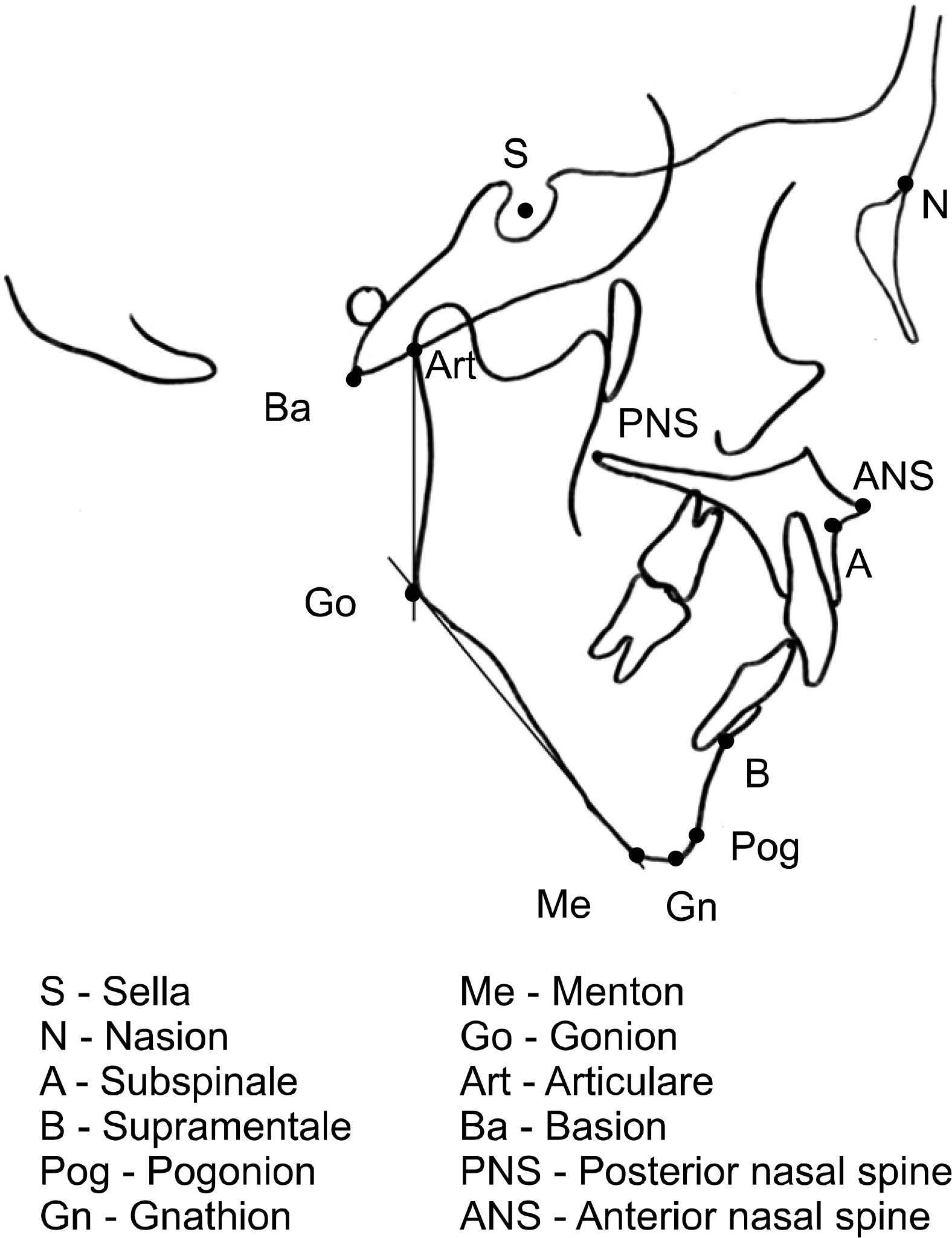The effect of growth hormone treatment on craniofacial growth in short stature children
- Affiliations
-
- 1Graduate School of Department of Medical Science, Yeungnam University, Korea.
- 2Department of Dentistry, College of Medicine, Yeungnam University, Korea. lhk@med.yu.ac.kr
- 3Department of Pediatrics, College of Medicine, Yeungnam University, Korea.
- 4Department of Orthodontics, College of Dentisrty, Yonsei University, Korea.
- KMID: 1975603
- DOI: http://doi.org/10.4041/kjod.2010.40.4.227
Abstract
OBJECTIVE
The purpose of this study was to analyze the effect of growth hormone treatment (GHT) on craniofacial growth in children of short stature.
METHODS
Nineteen untreated children of short stature were referred from the Pediatric Department, Yeungnam University Hospital as a subject group. All subjects had lateral cephalograms taken before, after 1 year and after 2 years of growth hormone treatment. As a reference group, we selected 19 normal children with paired sampling who matched the subjects' age and sex, from the Department of Orthodontics, Kyungpook National University Hospital.
RESULTS
Before GHT, anterior cranial base length and upper posterior facial height, posterior total facial height, mandibular ramus length, and mandibular corpus length were significantly smaller in the reference group. In angular craniofacial measurements, saddle angle and mandibular plane angle were larger. SNA and SNB were smaller in the reference group. After two years of GHT, growth hormone accelerated growth in several craniofacial components. The posterior total facial height, the anterior, posterior cranial base length, and the mandibular ramus length were increased. And the difference in mandibular plane angle and ANB values compared with the reference group was decreased.
CONCLUSIONS
GHT over 2 years leads to a craniofacial catch-up growth tendency, which is pronounced in interstitial cartilage and condylar cartilage.
Figure
Cited by 3 articles
-
Severe trismus due to bilateral coronoid process hyperplasia in growth hormone therapy patient: a case report
Sung-Tak Lee, In-Kyo Chung
J Korean Assoc Oral Maxillofac Surg. 2012;38(4):249-254. doi: 10.5125/jkaoms.2012.38.4.249.Evaluation of craniofacial morphology in short-statured children: growth hormone deficiency versus idiopathic short stature
Ki Bong Kim, Eun-Kyong Kim, Kyung Mi Jang, Min Seon Kim, Eun Young Park
Yeungnam Univ J Med. 2020;38(1):47-52. doi: 10.12701/yujm.2020.00325.A systematic review of treatment and outcomes in patients with mandibular coronoid process hyperplasia
Griet I.L. Parmentier, Margaux Nys, Laurence Verstraete, Constantinus Politis
J Korean Assoc Oral Maxillofac Surg. 2022;48(3):133-148. doi: 10.5125/jkaoms.2022.48.3.133.
Reference
-
1.Brown T. Skeletal maturity and facial growth assessment. Aust Orthod J. 1970. 2:80–7.2.Scammon RE. Measurement of the body in childhood. In: Harris JA, Jackson CM, Patterson DG, Scammon RE editors. The measurement of man. Minneapolis: University of Minnesota;1930.3.Cohen P., Rogol AD., Deal CL., Saenger P., Reiter EO., Ross JL, et al. Consensus statement on the diagnosis and treatment of children with idiopathic short stature: a summary of the Growth Hormone Research Society, the Lawson Wilkins Pediatric Endocrine Society, and the European Society for Paediatric Endocrinology Workshop. J Clin Endocrinol Metab. 2008. 93:4210–7.
Article4.Spiegel RN., Sather AH., Hayles AB. Cephalometric study of childeren with various endocrine diseases. Am J Orthod. 1971. 59:362–75.5.Kjellberg H., Beiring M., Wikland KA. Craniofacial morphology, dental occlusion, tooth eruption, and dental maturity in boys of short stature with or without growth hormone deficiency. Eur J Oral Sci. 2000. 108:359–67.
Article6.Hwang CJ., Cha JY. Orthodontic treatment with growth hormone therapy in a girl of short stature. Am J Orthod Dentofacial Orthop. 2004. 126:118–26.
Article7.Nanda RS. The rate of growth of several facial components measured from serial cephalometric roentgenograms. Am J Orthod. 1955. 41:658–73.8.Björk A., Helm S. Prediction of the age of maximum pubertal growth in body height. Angle Orthod. 1967. 37:134–43.9.Baughan B., Demirjian A., Levesque GY., Lapalme-Chaput L. The pattern of facial growth before and during puberty, as shown by French-Canadian girls. Ann Hum Biol. 1979. 6:59–76.
Article10.Isaksoon OG., Lindahl A., Nilsson A., Isgaard J. Mechanism of the stimulatory effect of growth hormone on longitudinal bone growth. Endocr Rev. 1987. 8:426–38.11.Bajpai A., Menon PS. Growth hormone therapy. Indian J Pediatr. 2005. 72:139–44.
Article12.Rongen-Westerlaken C., vd Born E., Prahl-Andersen B., von Teunenbroek A., Manesse P., Otten BJ, et al. Effect of growth hormone treatment on craniofacial growth in Turner's syndrome. Acta Paediatr. 1993. 82:364–8.
Article13.Bergersen EO. The male adolescent facial growth spurt: its prediction and relation to skeletal maturation. Angle Orthod. 1972. 42:319–38.14.Graber TM. Orthodontics: principles and practice. 3rd ed.Philadelphia: W.B. Saunders;1972. p. 27–128.15.Coben SE. Growth concepts. Angle Orthod. 1961. 31:194–201.16.Sohn BW., Kim HS. A semilongitudinal study on cranial base, maxillary and mandibular growth of Korean children aging 7 to 17 years old. Korean J Orthod. 1999. 29:23–35.17.Hunter CJ. The correlation of facial growth with body height and skeletal maturation at adolescence. Angle Orthod. 1966. 36:44–54.18.Van Erum R., Mulier M., Carels C. Verbeke G, de Zegher F. Craniofacial growth in short children born small for gestational age: effect of growth hormone treatment. J Dent Res. 1997. 76:1579–86.19.Pirinen S., Majurin A., Lenko HL., Koski K. Craniofacial features in patients with deficient and excessive growth hormone. J Craniofac Genet Dev Biol. 1994. 14:144–52.20.Ranly DM. A synopsis of craniofacial growth. 2nd ed.Norwalk, Conn.: Appleton & Lange;1984. p. 124–41.21.Tanaka T., Satoh M., Yasunaga T., Horikawa R., Tanae A., Katsumata N, et al. When and how to combine growth hormone with a luteinizing hormone-releasing hormone analogue. Acta Paediatr Suppl. 1999. 88:85–8.
Article
- Full Text Links
- Actions
-
Cited
- CITED
-
- Close
- Share
- Similar articles
-
- Short Stature and Growth Hormone Therapy
- Growth Hormone Therapy in Short Stature Children
- The effects of human growth hormone on short stature
- Approach to Short Stature in Children and Adolescent
- Responses to Growth Hormone Treatment in Children with Short Stature Secondary to Intrauterine Growth Retardation


